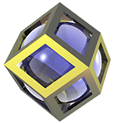Theoretical physicists are presently waiting impatiently for any kind of experimental clue that there is still something to explain – something significantly beyond the Standard Model. In the recent past there have been some notable close calls. I direct your attention to Sabine’s take on the diphoton anomaly in her book, Lost in Math, and this recent article in Quanta Mag. In particular, the point of highlighting these two short-lived instances of giddy excitement is that not only did these ephemera give rise to hundreds of papers with ready explanations of false data, but the theoretical milieu in which the authors work and strive was able to give rise to such nonsense. The reason for this is simple: that milieu lacks sufficient constraints to limit these potential Nobel prize winners’ theoretical ramblings.
Ideally they ought to have been able to tell the experimentalists that they should recheck their results, for they are inconsistent with accepted and proven theoretical canon. But this is not – and seems unlikely ever to become – the case.
In my lifetime numerous Nobel Prizes have been awarded to people who realized that crazy noncommutative Lie groups could help explain the structure of reality. This was initially a huge OMG moment for science, made all the more mind boggling when it was recognized that after 1 (U(1)) and 2 (SU(2)) comes 3 (SU(3)), and 3 also had a role to play. Shortly after that some mathematician, presumably, pointed out to the celebrating physicists that the set of integers extends beyond 3. And so the merry chase was on: SU(5); SO(8); SO(10); SO(32); E8; … This was diphoton anomaly stuff on a majestic scale, stemming, of course, from the fact that no one understood where the first three groups came from, or why they worked. So, having no architecture to limit their brilliance, off they went in a decades long chase after the next big thing (group). They could console themselves that they were doing hard science, because it was hard, relying on QFT, where the T there stands for theory.
In reality it isn’t a theory, though, is it? It’s a tool, and one that is only vaguely understood (“shut up and compute”). And it rests on a collection of quantum ideas whose meaning has defied over a century of deep philosophical blather. Peter Woit’s blog is my favorite, but every time his latest screed touches on anything quantum the comments section blossoms into a rich weedy field of “No, you’re not thinking of it right; you want to think of it my way!” debate that can have no resolution, because evidently all ways of interpreting QM lead to the same real world conclusions – or at least those that get any attention.
Still, if you want a career in physics the quantum road is paved in gold, especially now with quantum computing receiving so much attention, and Sky Net just around the corner. As to me, well, I ignored all those road signs that indicated “Exit here for QFT and Career”. As a graduate student every time I dabbled in QFT my spidey sense went crazy, warning me that immersion in its arcana would not take me where I wanted to go, which – although I did not realize this then, despite repeated warnings from the well-meaning – was not to a sinecure in academia.
There’s nothing wrong with QFT (well, …), but it lacks rigidity. It’s a tool. SU(2) and SU(3) were ok, but nothing in the way we did (do) physics was up to the task of limiting further speculation along these lines. Our theoretical foundation (TF) was powerful enough to say, well, if we want SU(5) then the proton should decay, and if it doesn’t (and it doesn’t) then we need to throw out SU(5). But the TF wasn’t even remotely sufficiently constrained to preclude SU(5) from the outset. And that’s because we never understood where the 1,2,3 came from in the first place, and as physicists (and not mathematicians) we didn’t concern ourselves with such issues. We apply; we don’t explain.
Ok, so now let’s do a Gedanken Experiment a la Thanos (warning: you are not alive in this experiment; oh, and failure to connect with past and future pop-culture references is of no concern to me). With a snap of his gauntleted fingers all sentient life … oh, hell, let’s make it all life … throughout this or any universe is gone. Eradicated. There’s still matter, and said matter clumps into balls, and the surfaces of these balls are what we called 2-spheres (before our eradication). And it’s still true that if one of these 2-spheres were really really smooth and hard, with a one atom thick atmosphere of He, the motion of these He atoms (the planet’s wind) could not be everywhere nonzero (speed units unspecified, as no life exists to specify them). For a similar reason no grid could appear on the surface of the 2-sphere that did not have poles. Indeterminacy in one of the two dimensions at some position is certain.
For the 1-sphere (circle) this is not the case. We use degrees or radians to indicate position, and there are no indeterminate coordinates. Were this not the case the Fourier transform would be impossible, and quantum theory would cease to function.
But in a universe without life there would be no QM, or QFT, or hammers, and for much the same reason. They’re all tools. But there would still be parallelizable spheres (1-sphere), and nonparallelizable spheres (2-sphere), with real lifeless universe physical consequences in both cases. And it would still be true that of all possible n-spheres only those of dimension 1, 3, or 7 (and arguably 0) are parallelizable. These dimensions (and the associated 1, 2, 4, and 8) are what I call resonant. If we allow for the existence of one sentient creature (which for purely selfish reasons I choose to be me), then I would find dealing with this resonance easiest were I to develop algebra (a tool), and these algebras in particular: real, complex, quaternion, and octonion. And after a bit more solitary cogitation I discover the sequences of Lie groups: SO(n), SU(n), Sp(n), and a few exceptional groups, all associated with the respective division algebras. The list of mathematics that bubbles up from these algebras goes on, and try as I might I would find little of interest completely unconnected to these mathematical resonances.
And what of physics? Well, in my pocket I discover some notes on Dirac theory. Generalizing from that, I discover (predict): spinors constructed from T = C⊗H⊗O reduce to a family of quarks and leptons existing in my 1,3-dimensional universe; and there is a mirror universe dominated by the antiparticles of those fermions; and vector bosons arise from gauging what I’d call the Standard Symmetry which arises naturally from T-maths; and connecting the two mirror universes is a 6-dimensional space carrying SU(3) charges. Then, if I felt really bored, I might invent QFT with which to generate numbers. Or, I might not, as I suspect that there’s something wrong with it. No point getting carried away and risking yet another universe-wide eradication of all life, albeit at this point just me.


In the beginning “And it would still be true that of all possible n-spheres only those of dimension 1, 3, or 7 (and arguably 0) are parallelizable.” these three spheres are places where absolute motion can’t be defined by combing their hair to create “fixed points”. But the seven sphere has 28 diffeomorphism classes per homotopy type (page 222 of Topology and Geometry for Physicists by Nash and Sen). Can these 28 classes be used to define absolute motion? Or anything useful for physics?
My question about the 28 diffeomorphism classes was caused by,
28 + 2 = 30
28 + 8 = 36
28 + 24 = 52
from your “Some numerology relating to the number 24” post. I’ve almost always conjectured that this breaking of diffeomorphic invariance would generate curvature causing the seven sphere to shrink to the Planck scale? Couldn’t think of what else would do that.
Well, I don’t know. I’ve always tried to avoid too much conjecture. And I’m retired now. Let the mathematics talk, and don’t try to bend it to your will. But there are clearly 7-sphere avenues as yet unexplored.